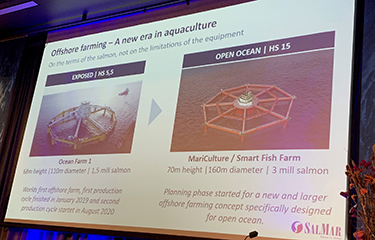Offshore salmon farming “the right direction” for SalMar

The first generation of salmon harvested at SalMar ASA’s Ocean Farm 1 and the preliminary results seen from the offshore facility’s second generation have confirmed that technologies which allow significant volumes to be produced in large, open-ocean locations around Norway and other regions are a genuine opportunity for the industry, SalMar CFO and COO Trine Sæther Romuld said.
Romuld said at the North Atlantic Seafood Forum (NASF) 2020 that the Freya, Norway-headquartered SalMar – the fourth-largest Atlantic salmon farming company and the world’s largest producer of organic salmon – has “a very strong belief” in the potential to produce fish out in open-ocean currents.
While conventional fish farming near the coast will continue to be important, Norwegian aquaculture has a great opportunity to achieve “significant sustainable growth” by utilizing these further offshore, exposed locations, she said.
“SalMar aims to lead this development. We believe that most of our volume growth will come from this area in the times ahead,” Romuld said.
Describing salmon as “one of the most resource-efficient protein sources,” and emphasizing its importance as a means to feed “a rapidly growing population,” Romuld said the salmon farming sector is now required to produce larger volumes more sustainably and more efficiently.
“For us, this is about making better use of the ocean space in the years ahead,” she said. “Therefore, at SalMar, we have divided the direction of our salmon production in two. We have the coastal areas and this will continue to be the core salmon production in the coming years. In these areas we will still be at the forefront with an uncompromising focus on cost and a desire to always do things a little better tomorrow than we did today and yesterday. In addition, we want to lead the development of offshore farming, utilizing the fantastic ocean for the production of salmon. We will strengthen this work through our newly-founded company SalMar Ocean. We have achieved good biological results at Ocean Farm 1 and harvested fish of fantastic quality. For us, this was a major milestone. It confirmed that offshore farming truly is a sustainable means of production.”
SalMar recently launched ocean-based fish farming subsidiary SalMar Ocean AS, which operates Ocean Farm 1, an offshore cage. Meanwhile, subsidiary MariCulture AS is finalizing the design phase of a larger and more advanced offshore cage, Smart Fish Farm, which will be placed in the open sea. The unit is led by former CEO Olav Andreas Ervik.
“We strongly believe that offshore salmon farming is the right direction, where we can utilize the optimal, natural conditions for raising these fish in the ocean outside of Norway," Romuld said. "This can also help solve the area challenges facing the industry – by opening up entirely new areas that are optimal for salmon farming."
To take this strategy further, SalMar wants to extend the exposed, semi-offshore farming conducted through Ocean Farm to its new “Smart Fish Farm” concept, which has been specifically designed to enable the company to farm salmon in much deeper open-ocean environments.
“The experience we have from the first generation harvested from Ocean Farm 1 has strengthened our confidence that this is the right direction,” Romuld said. “Its first production cycle was completed early in 2019 with strong biological results – very good growth, good quality, a more even size in the harvested fish with less losers and more winners.”
The second generation, meanwhile, has overcome some brutal weather to perform even better, with mortalities and sea lice also kept at stable low levels. Costs have largely remained on par with SalMar’s conventional farm locations.
However, the fact that sea lice treatments are still required has strengthened the company’s conviction that farming further offshore is the right direction, she explained.
“We want to go even further out in the ocean – to build on the experience we have from Ocean Farm and use it in the open ocean with our Smart Fish Farm,” Romuld said.
With a net height of 70 meters, a diameter of 180 meters, and the capacity to host three million smolts, the Smart Fish Farm is twice the size of Ocean Farm 1. SalMar is currently working with Norwegian authorities to find a suitable location to test the concept, and while the current focus is to use this system in the open ocean off Norway, inquiries have begun pouring in from other regions, including Asia, Europe, and North America.
“This opens up new ways for the industry to grow,” Romuld said.
In 2019, SalMar produced 166,200 metric tons (MT) of salmon, with 143,300 MT coming from its operations in northern and central Norway. Its farms in Scotland and Iceland contributed 25,900 MT and 9,900 MT, respectively.
Its forecast for 2020 is a total harvest of 177,000 MT.
Photo courtesy of Jason Holland






Share